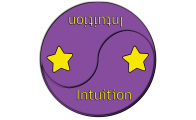Yin and Yang

The colors also emerge from the symbol on my Yang cards, which modifies the traditional Yin-Yang symbol, sometimes incorporating one or two colors in addition to black and white.
The Yin and Yang symbol embodies masculinity and femininity, positivity and negativity, above and below, right and left, light and darkness—all opposing forces encompassing everything and nothing.
This universal symbol is known to many, but have you delved deeper into its meaning? The white field signifies masculinity, and the black field represents femininity. Each contains a dot of the opposite, forming a perfect balance of positive and negative.
This symbol illustrates contrast; for every 'up,' there is a 'down,' and a force—KI—is created through the positive and negative. Positive acknowledges the bright, creative force, whereas Negative, far from being bad, invites receptivity and waiting experience. Yang symbolizes the sun, while Yin represents the moon, including our shadow side, the hidden.
Legend holds that Yin and Yang arose from chaos during the universe's formation as a balance at Earth's center. They are extreme counterparts, and the energies that became the first men and women. Yin and Yang are the cornerstones of Chinese philosophy, Taoism, and medicine. They interdependently function—without one, imbalance may reign, causing energy surpluses, even in our bodies.
Yin corresponds to the left heart chamber and the right brain hemisphere, while Yang represents the right and left hemispheres. Together, they complete the Yin and Yang symbol. A balance between feeling and thought is vital.
Equitable energy flow fosters harmony; imbalance arises when dominance occurs. This principle applies universally, from the macro to the microcosm. Excessive Yang can lead to natural disasters, but abundant Yin can cause similar effects. These two energies perpetually flow within us.
Yin and Yang also represent the five elements. The expansive white field signifies Fire, with the small black dot as Water. The vast black field symbolizes Earth, while the white dot represents Air. However, interpretations vary among different cultures. Fire and Air are always Yang, whereas Water and Earth are Yin. Combined, the four elements form ether, or metal, in Chinese medicine.
These four segments of Yin and Yang also embody our seasons: the Winter Solstice within the black field, the Spring Equinox as the white dot, the Summer Solstice in the white field, and the Autumn Equinox as the black dot.
Moreover, they represent the day:
- Morning: the white field.
- Day: the black field.
- Evening: the black dot.
- Night: the white dot.
Furthermore, Yin correlates with even numbers (2, 4...), while Yang aligns with odd numbers (1, 3...).

